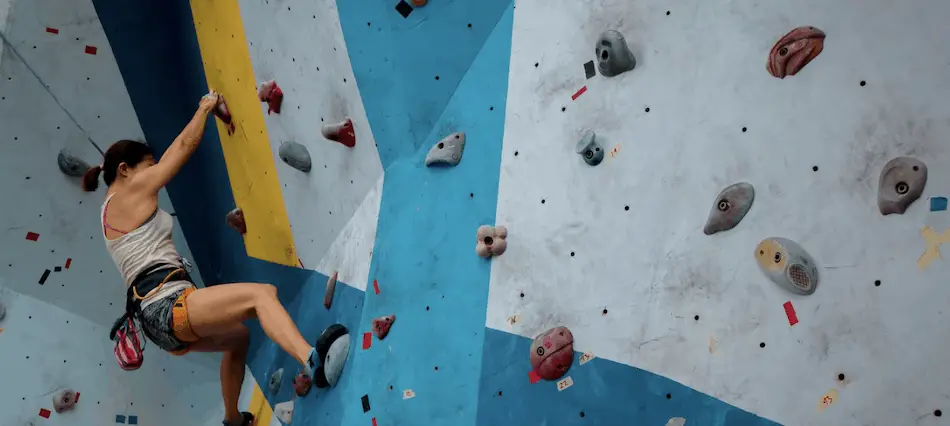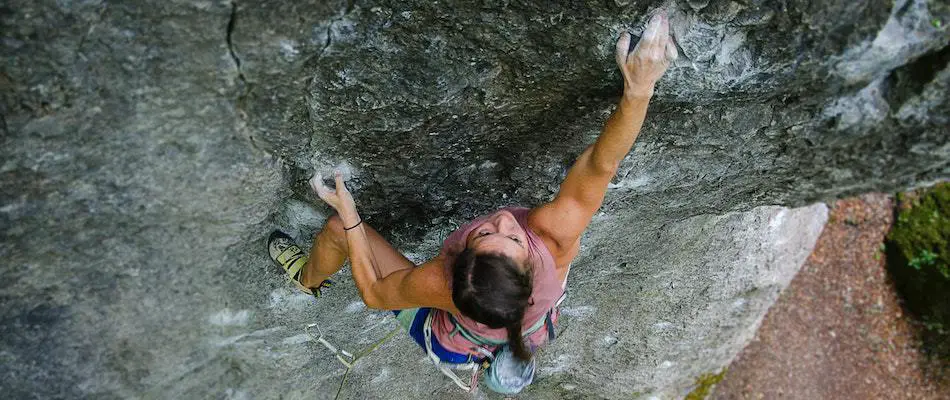
Physical size is a big deal in sports, but climbing is a little bit different than, say, football. I decided to do some research to see what the ideal height for rock climbers is.
The best height for male rock climbers is 5’9, and the best height for female rock climbers is 5’4, based upon the average height of the climbers competing in the 2021 Olympics.
Read on for a more in-depth analysis on whether or not there’s a correlation between height and rock climbing skill!
Being tall won’t necessarily make you a better climber, contrary to what some people may think. While it does have certain advantages, such as reaching holds easier, it can also make your life more difficult in other ways (which I analyze further in this article). My analysis of the 40 best climbers in the world, using both some raw data and the eye test, indicated that there’s no such thing as an ideal height for a rock climber
What’s the Best Height for a Rock Climber?
I wanted to see if there was such thing as an ‘ideal’ or best height for rock climbers. To test this, I calculated the average height of all 40 climbers who competed in the most recent olympics.
For men, the ‘ideal’ or average rock climbing height is 5’9, and for women, the ideal height is 5’4. However, it should be noted that there’s a wide range in the heights of top-level climbers, and height is not a direct indicator of climbing ability.
While these averages provide a bit of guidance, there are a few reason’s I don’t think they can be trusted. Mainly, it should be noted that there’s a wide variance in this data set; the shortest climbers (5’6 for men and 5’0 for women) and the tallest climbers (6’2 and 5’8, respectively) were both among some of the best in their respective divisions.
So, based on the above data, you can draw two main conclusions:
- The ‘ideal’ height for a rock climber is fairly close to the global averages for men and women
- Height and climbing skill are not necessarily correlated
On one hand, you could take the averages above and say that the ideal rock climber is 5’9 for men and 5’4 for women. On the other hand, you could make a pretty good argument that if you take an average of any 20 people’s heights, the numbers you’ll get are fairly similar to the number that I just found.
This leads to the interesting question: is there actually such thing as an ideal height for rock climbers? Is there any correlation between height and rock climbing skill?
I’m going to try to answer this question both using the numbers above and my own personal experience.
Is it Better to Be Tall of Short for Rock Climbing?

Given that there are world-class climbers of all shapes and sizes, it’s fair to wonder if there’s any advantage to being tall when rock climbing.
On average, being taller will make climbing relatively easier, as you can grab holds that short climber’s can’t. However, height also comes with some less-noticeable disadvantages, such as being heavier and not being able to fit yourself in certain positions.
As a tall person, I have to admit that my height is often an advantage when climbing. It allows me to make large moves and sometimes jump between holds; occasionally, I’m even able to skip an entire sequence by just reaching past it.
However, as I said, this height isn’t always advantageous. On cramped moves like a sit start, I have trouble fitting all of my limbs in place and sometimes can’t do it. Additionally, the extra weight that comes with being taller sometimes works against me, as I’m not as strong on small holds.
Finally, I think there’s one disadvantage to being tall that isn’t talked about as much. When you’re a shorter climber, you’re often forced to come up with creative ways to work through sequences, which helps build your skill and thoughtfulness.
If, when you’re a new climber, you’re tall enough to just reach past the holds, you won’t have to do this same problem-solving. Therefore, you never get to practice it, and your skills may not develop to quite the same degree. This is the reason that a ton of shorter climbers are more skill based, like Ashima Shiraishi or Jain Kim, while taller climbers like Janja Garnbredt tend to be more power-focused.
So, my overall answer to the question of whether or not it’s better to be short or tall for rock climbing is this: while being tall may give you some advantages, there are also drawbacks and physical restrictions that come with it. Being tall may make climbing easier, but it won’t necessarily make you better.
I think the data backs this up. Alberto Gines Lopez, one of the shortest male climbers, won gold at the Olympics. Adam Ondra, one of the tallest, came sixth. On the flipside, Janja Garnbredt, one of the tallest female climbers, won the gold, while Laura Rogora, the shortest, didn’t even qualify for the final.
Although you can pull an average to try to come up with a ‘best’ height for rock climbers, the eye test shows that it’s less about how tall you are and more about how you learn to use your height to your advantage
What’s the Ideal Physique for Rock Climbers?
Along with questions of height comes similar questions about physique. Lots of people wonder what the ideal physique for rock climbers is.
The ideal physique for a rock climber is one with a decent amount of muscle, low body fat, and arms that are 3-5 inches longer than they are tall. Muscle mass is fairly irrelevant in a climber’s physique, as is overall height. What’s more important is how long a climber’s arms are compared to their body.
Although many people think that being skinnier is better for climbing, that isn’t necessarily true. Lots of climbers have packed on decent amounts of muscle without it impacting them too much (see, for example, Magnus Midtbø).
Now, there obviously is a limit to this. A professional strongman won’t make a good climber, because they simply have too much mass to haul up the walls. However, in the scope of normal people, those who are skinnier won’t necessarily be better
In fact, being too skinny can actually be a detriment to your climbing, as you won’t have the strength to do ultra-burly moves. More muscle means you have more ability to hold your body in position, and most good rock climbers, while not being super jacked, could at least be considered lean and wiry.
Something more important than weight is the proportion of your arm length to your height, or what’s known as ape index. Conventional wisdom says a higher ape index (e.g., having longer arms) is better for rock climbing, as it allows you to more easier reach between holds.
However, there is a bit of a downside to having super-long arms, as it creates more leverage. More leverage means you need more force to pull yourself up the wall or hold yourself in difficult positions, like an undercling. So, as with everything else we’ve talked about in this article, there’s a bit of a trade-off.
